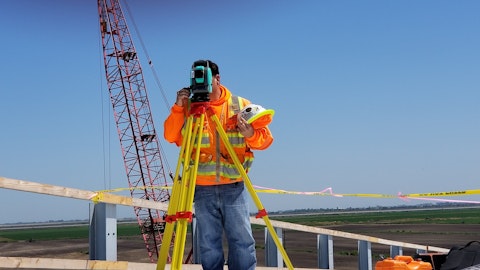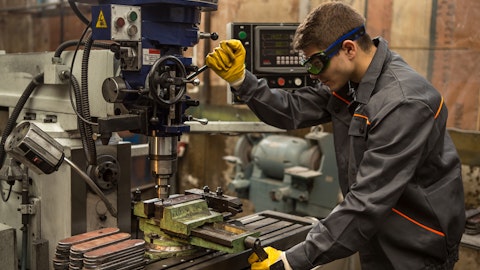Seth Weber: Got it. Thank you. Maybe just a follow-up on AWP. I guess, can you just talk to the backlog that you have? Is all of that for 2024? And can you — are you seeing any cancellations or push outs from your customers in the AWP business? Thank you.
Simon Meester: Yeah, thanks for the question. Obviously, strong sequential bookings in AWP, up 59%. Still record high backlog, 3x historical levels. I would say for AWP, it’s not really a demand issue, very strong underlying demand. Not all the negotiations with the nationals were booked in the fourth quarter. Some of that will drop in the first quarter. So, we expect some more strong bookings to come in the first quarter. Utilities within AWP is taking bookings for 2025. I would definitely say we have a strong order book. It’s sticky. We don’t see cancellations. It gives us a lot of confidence going into 2024.
Seth Weber: Great. Okay. Thank you, guys. I appreciate the comments.
Julie Beck: Thanks, Seth.
Operator: Your next question comes from the line of Steve Fisher with UBS. Your line is open.
Steve Fisher: Great. Thanks. Good morning, and congrats, Simon. Just trying to get a sense of your North American AWP volume expectations for 2024. I guess with overall sales flat, I assume you have some positive pricing, some growth in parts and utility. I assume Europe is down a few percent. Are we thinking North American volumes are expected to be kind of up mid single-digits? And I’m just curious kind of what the sentiment from the broad rental channel is. Are they telling you that their fleet spending is up, down or flat this year? And how they’re framing that in a broader [indiscernible] context?
Simon Meester: Yeah. You got it right on the first — on your first assumption, North America up, Europe probably a little down. Overall, as I said, strong backlog going into the year, strong bookings, but some caution about Europe. North America demand — underlying demand very, very strong. There’s still a little bit of a supply chain disruption even though it has greatly improved versus the beginning of 2023. Still it only needs — it only takes one part for us to stop a shipment that we can’t complete a product. But yeah, in terms of activity with our nationals, our large customers in North America, they’re all very bullish. They all feel that 2024 is another strong year. As a matter of fact, 2025 seems to be strong as well.
So, it seems to carry forward. And I would say, overall, we do see probably a little bit more activity with our nationals going into 2024 just because of their exposure to the mega projects. But overall, as a global business, it doesn’t really impact us from a mix standpoint, because it just kind of washes out globally in terms of product and geographic mix.
Steve Fisher: Okay. That’s very helpful. And then just a follow-up on Europe. Excuse me. Did it get worse in the quarter? Is it stabilizing? How localized to any particular part of Europe is it? And how is competition a factor there?
Simon Meester: Yeah. Are you talking about AWP or Terex as whole?
Steve Fisher: AWP, yeah — actually, both would be good.
Simon Meester: Okay. Yeah, so I’ll start with AWP. So, it’s actually for both businesses, it’s mostly Germany and the UK. It’s a little bit Scandinavia. Germany and the UK is mostly non-res related. Scandinavia, it’s mostly resi, where it starts to slow down and it’s mostly impacting AWP and MP for that matter. In terms of MP, it’s mostly tied to the businesses that have a little bit more of European exposure. So think Fuchs, for example, is also tied, obviously, to the scrap market, but also our Cranes business, specifically our Tower Cranes business, with their exposure to the European market, they are facing some headwinds. So that’s what I would call out in terms of European exposure.
Steve Fisher: Okay. Thank you very much.
Operator: Your next question comes from the line of David Raso with Evercore ISI. Your line is open.
David Raso: Hi. Thank you. Good morning. I’m trying to think about the straddling of demand and supply for 2024 and 2025 for AWP. Might be a hard question to answer initially, but if you had Mexico running the way you expect, no labor constraints in some of the more mature AWP plants, can you give us some idea of what would the guide have been? I’m just curious, are we talking a couple of hundred dollars of revenue that you could be shipping in ’24 that at the current moment you’re saying you can’t? And then, the follow-up would be, do you see that simply getting pushed to ’25, or has maybe some incremental capacity loosened up elsewhere in the industry that unfortunately that might be just simply a lost sale? So, I’m just trying to think about the tightness right now, the inability to ship, and what does that do to the arc of the AWP cycle for ’24 and ’25.
Simon Meester: Yeah, thanks for the question, David. So first of all, for everyone’s math, there’s about $300 million in the AWP backlog that’s already carried over to 2025. So the backlog numbers that we’re reporting is not all for 2024. There’s about $300 million of that already allocated to 2025. So, we have about nine to 10 months coverage currently in the backlog for 2024. In the case of Monterrey, I would say, we’re obviously ramping up a very large facility, as Julie mentioned, large facility we’ve ever built, and we’re very happy with progress we’re making. We’re still very much on track to deliver on the 200 basis points commitment that we made for 2025 in terms of operating margin improvement. And I would say that if supply chain continues to improve in the current trends, there’s definitely upside to our guidance, to our sales outlook, and we would be towards the upper end of that range.



